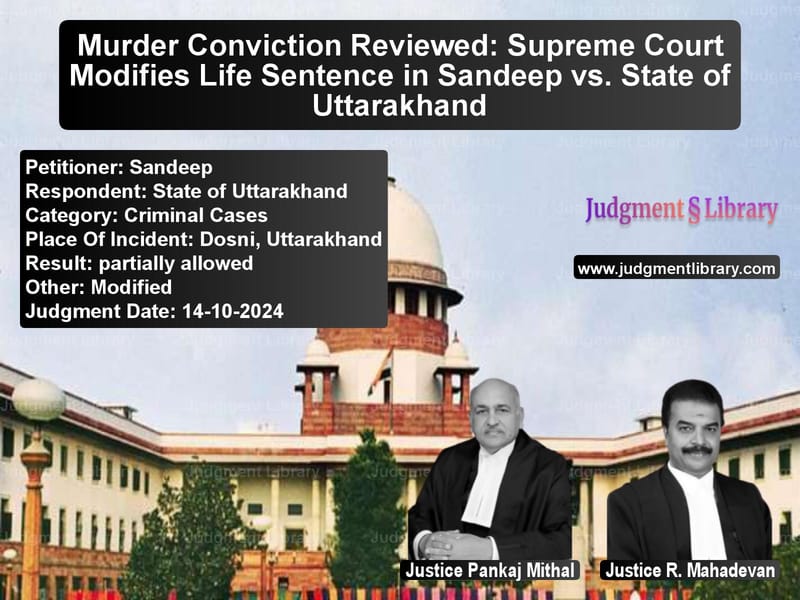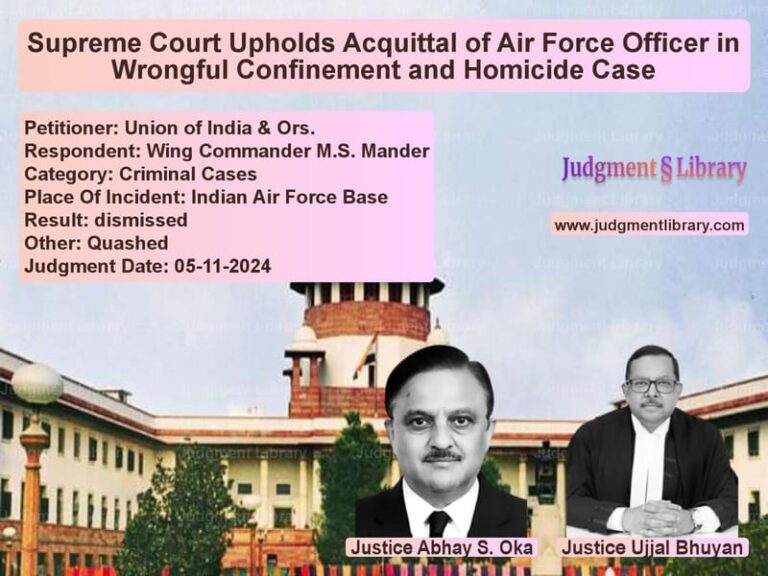Murder Conviction Reviewed: Supreme Court Modifies Life Sentence in Sandeep vs. State of Uttarakhand
The case of Sandeep vs. State of Uttarakhand revolved around a brutal murder that took place in 1997. The appellant, Sandeep, was convicted under Section 302 read with Section 34 of the Indian Penal Code (IPC) for the murder of one Abdul Hameed. The trial court sentenced him to life imprisonment, which was later upheld by the High Court of Uttarakhand. However, upon appeal to the Supreme Court, the sentence was reconsidered in light of the circumstances surrounding the crime, and ultimately, it was modified.
Background of the Case
The case dates back to 30.10.1997, when Abdul Hameed was shot dead in his courtyard in the village of Dosni, Uttarakhand. The prosecution alleged that four men—Veer Singh, Mintu, Dharamveer, and Sandeep (the appellant)—arrived at the victim’s house and, following a dispute over jaggery (GUR), shot him in the chest. The incident was reportedly witnessed by the deceased’s son, Kale Hasan (PW1), and grandson, Gufran Ali (PW2).
The police registered a case under Section 302 IPC and also booked the accused under the Arms Act, 1959. However, during the trial, three of the accused—Veer Singh, Dharamveer, and Mintu—were acquitted, while Sandeep was convicted of murder.
Key Legal Issues Considered
- Whether the conviction of Sandeep under Section 302 IPC read with Section 34 was justified, given that all co-accused were acquitted.
- Whether the evidence of PW1 and PW2 was reliable and sufficient to convict Sandeep.
- Whether the appellant’s acquittal under the Arms Act had any bearing on his conviction under Section 302 IPC.
- Whether the sentence of life imprisonment was justified based on the mitigating and aggravating circumstances.
Petitioner’s (Sandeep’s) Arguments
The defense put forth the following arguments:
- The prosecution failed to prove common intention under Section 34 IPC since all co-accused were acquitted.
- There were contradictions in the eyewitness testimonies. PW1 and PW2 claimed to have seen the shooting but did not have any bloodstains on their clothes.
- The prosecution failed to establish the source of light at the scene of the crime.
- The trial court had acquitted the appellant of charges under the Arms Act, raising doubts about the firearm’s possession and use.
- The appellant had already served over 14 years in prison, demonstrating good conduct throughout.
Respondent’s (State of Uttarakhand’s) Arguments
The prosecution countered with the following points:
- PW1 and PW2 had clearly identified Sandeep as the shooter.
- The appellant had a motive—he and his co-accused had earlier demanded jaggery, and the deceased’s refusal led to the attack.
- A country-made pistol was recovered from the appellant, strengthening the case.
- The medical evidence and forensic reports confirmed that the victim had died due to gunshot wounds.
- The trial court’s decision to convict Sandeep was based on consistent and corroborated evidence.
Supreme Court’s Observations
1. Reliability of Eyewitness Testimonies
The Court found that PW1 and PW2 had consistently identified Sandeep as the shooter. However, it noted that there were minor contradictions in their statements, particularly regarding whether they saw the accused firing or merely found the victim shot.
2. Lack of Common Intention
The Court noted that while Sandeep had been convicted under Section 34 IPC, the co-accused had been acquitted. The judgment stated:
“For a person to be convicted under Section 34 IPC, there must be an involvement of two or more persons with a common intention to commit the crime. Mere presence of the accused at the scene of occurrence is not sufficient.”
As a result, the Court set aside Sandeep’s conviction under Section 34 IPC.
3. Sentencing Considerations
The Court considered several factors in determining an appropriate sentence:
- The murder was not premeditated.
- The incident arose out of a sudden provocation (denial of jaggery).
- The appellant had already served more than 14 years in prison.
- The appellant demonstrated good behavior while in custody.
- The appellant came from an economically disadvantaged background and had no prior criminal history.
Final Judgment
The Supreme Court issued the following ruling:
- The conviction under Section 302 IPC was upheld.
- The conviction under Section 34 IPC was set aside.
- The sentence of life imprisonment was modified to the period already undergone.
- The appellant was ordered to be released if not required in any other case.
Conclusion
The Supreme Court’s ruling in Sandeep vs. State of Uttarakhand reinforced the principle that common intention under Section 34 IPC cannot be assumed merely due to the presence of multiple accused. Additionally, the judgment highlighted the importance of considering mitigating factors in sentencing.
This case serves as a reminder that the justice system must balance punishment with fairness, particularly when an accused has already spent a substantial period in prison and has shown the potential for reformation.
Petitioner Name: Sandeep.Respondent Name: State of Uttarakhand.Judgment By: Justice Pankaj Mithal, Justice R. Mahadevan.Place Of Incident: Dosni, Uttarakhand.Judgment Date: 14-10-2024.
Don’t miss out on the full details! Download the complete judgment in PDF format below and gain valuable insights instantly!
Download Judgment: sandeep-vs-state-of-uttarakhand-supreme-court-of-india-judgment-dated-14-10-2024.pdf
Directly Download Judgment: Directly download this Judgment
See all petitions in Murder Cases
See all petitions in Bail and Anticipatory Bail
See all petitions in Extortion and Blackmail
See all petitions in Attempt to Murder Cases
See all petitions in Judgment by Pankaj Mithal
See all petitions in Judgment by R. Mahadevan
See all petitions in partially allowed
See all petitions in Modified
See all petitions in supreme court of India judgments October 2024
See all petitions in 2024 judgments
See all posts in Criminal Cases Category
See all allowed petitions in Criminal Cases Category
See all Dismissed petitions in Criminal Cases Category
See all partially allowed petitions in Criminal Cases Category







